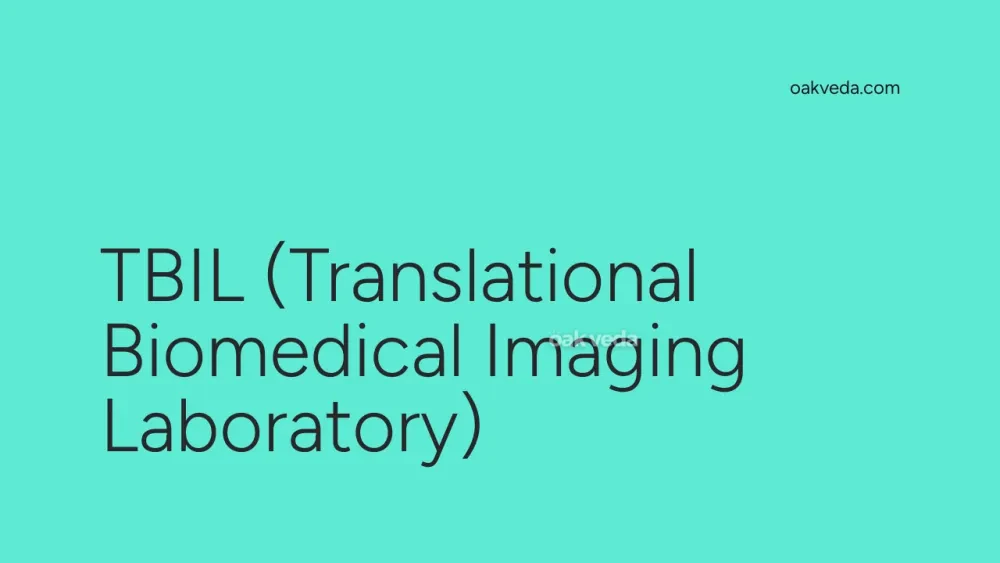
What is the Full Form of TBIL?
The full form of TBIL is Translational Biomedical Imaging Laboratory. This advanced research facility plays a crucial role in the field of medical imaging, contributing to scientific discovery and improved healthcare outcomes.
What is Translational Biomedical Imaging Laboratory?
Translational Biomedical Imaging Laboratory (TBIL) is a specialized research center dedicated to developing and applying cutting-edge imaging technologies for medical and biological research. It serves as a bridge between basic scientific discoveries and their practical applications in clinical settings, hence the term "translational."
Origin and Development of TBIL
The concept of translational biomedical imaging emerged from the need to accelerate the process of turning scientific discoveries into practical medical applications. As imaging technologies advanced rapidly in the late 20th and early 21st centuries, the establishment of dedicated laboratories like TBIL became crucial for harnessing these innovations for healthcare improvement.
How does TBIL work?
TBIL operates by bringing together multidisciplinary teams of scientists, engineers, and medical professionals. These experts collaborate to:
- Develop new imaging technologies
- Improve existing imaging methods
- Apply advanced imaging techniques to study biological processes
- Translate research findings into clinical applications
Types of Imaging Technologies Used in TBIL
TBIL employs a wide range of imaging technologies, including:
- Magnetic Resonance Imaging (MRI)
- Computed Tomography (CT)
- Positron Emission Tomography (PET)
- Ultrasound
- Optical Imaging
- Molecular Imaging
Functions of TBIL
The primary functions of TBIL include:
- Research and Development: Creating new imaging technologies and refining existing ones.
- Collaboration: Fostering partnerships between researchers, clinicians, and industry partners.
- Education: Training the next generation of biomedical imaging experts.
- Clinical Translation: Moving promising imaging techniques from the lab to clinical practice.
Applications of TBIL
TBIL's work has wide-ranging applications in healthcare and biomedical research:
- Disease Diagnosis: Developing more accurate and early detection methods for various diseases.
- Treatment Planning: Providing detailed imaging to guide surgical procedures and radiation therapy.
- Drug Development: Using imaging to assess the efficacy of new drugs in preclinical and clinical trials.
- Personalized Medicine: Tailoring treatments based on individual patient characteristics revealed through advanced imaging.
Features of TBIL
Key features of Translational Biomedical Imaging Laboratories include:
- State-of-the-art imaging equipment
- Interdisciplinary research teams
- Collaboration with clinical departments
- Access to patient data for research purposes
- Partnerships with industry for technology development and commercialization
Benefits of TBIL
The establishment of TBILs offers numerous benefits:
- Accelerated Innovation: Faster development and implementation of new imaging technologies.
- Improved Patient Care: More accurate diagnoses and personalized treatment plans.
- Economic Impact: Creation of new jobs and potential for commercialization of innovations.
- Educational Opportunities: Training for students and professionals in cutting-edge imaging techniques.
Limitations or Challenges of TBIL
Despite its potential, TBIL faces several challenges:
- High Costs: Advanced imaging equipment and research can be expensive.
- Regulatory Hurdles: Navigating complex regulations for clinical implementation of new technologies.
- Data Management: Handling and securing large volumes of imaging data.
- Ethical Considerations: Ensuring patient privacy and informed consent in research.
Future Developments in TBIL Technology
The future of TBIL is exciting, with several promising developments on the horizon:
- Artificial Intelligence Integration: Using AI to enhance image analysis and interpretation.
- Molecular Imaging Advancements: Developing more specific and sensitive molecular probes.
- Multimodal Imaging: Combining different imaging techniques for more comprehensive insights.
- Portable Imaging Devices: Creating smaller, more accessible imaging tools for point-of-care use.
FAQs on TBIL Full Form
-
What does TBIL stand for in medical terms? TBIL stands for Translational Biomedical Imaging Laboratory in medical terms.
-
How does TBIL contribute to medical research? TBIL contributes by developing new imaging technologies, improving existing methods, and applying advanced techniques to study biological processes and diseases.
-
Is TBIL only used in hospitals? No, TBIL is primarily a research facility that collaborates with hospitals, universities, and industry partners.
-
Can TBIL help in early disease detection? Yes, one of the main goals of TBIL is to develop more accurate and early detection methods for various diseases.
-
What types of professionals work in a TBIL? TBILs typically employ a diverse team including medical researchers, engineers, computer scientists, physicists, and clinicians.
It's worth noting that TBIL can also stand for Tiny BASIC Interpreter Language, a software tool used for data conversion and transliteration. However, in the medical and scientific context, Translational Biomedical Imaging Laboratory is the more common and relevant full form.
You may be interested in:

